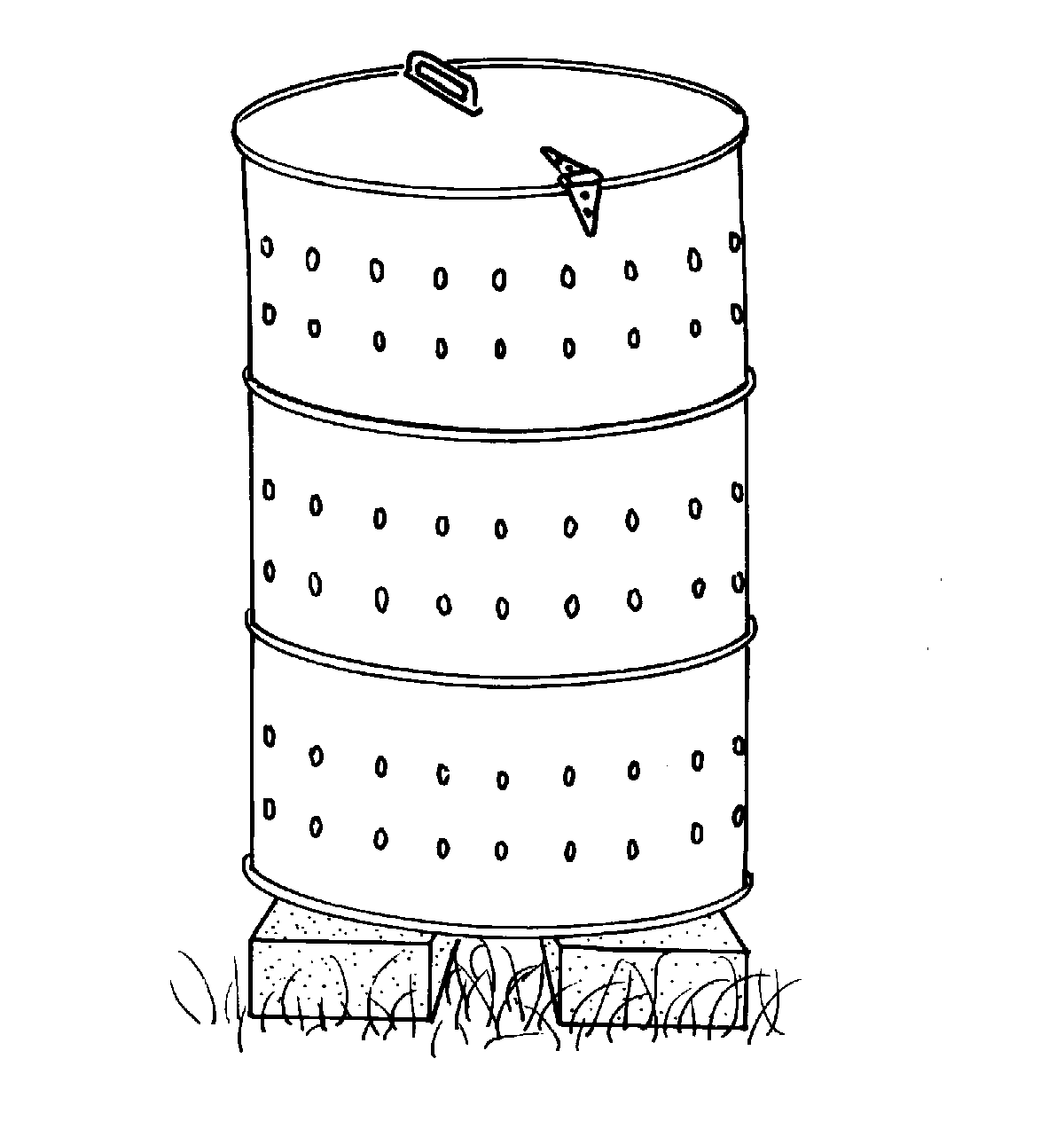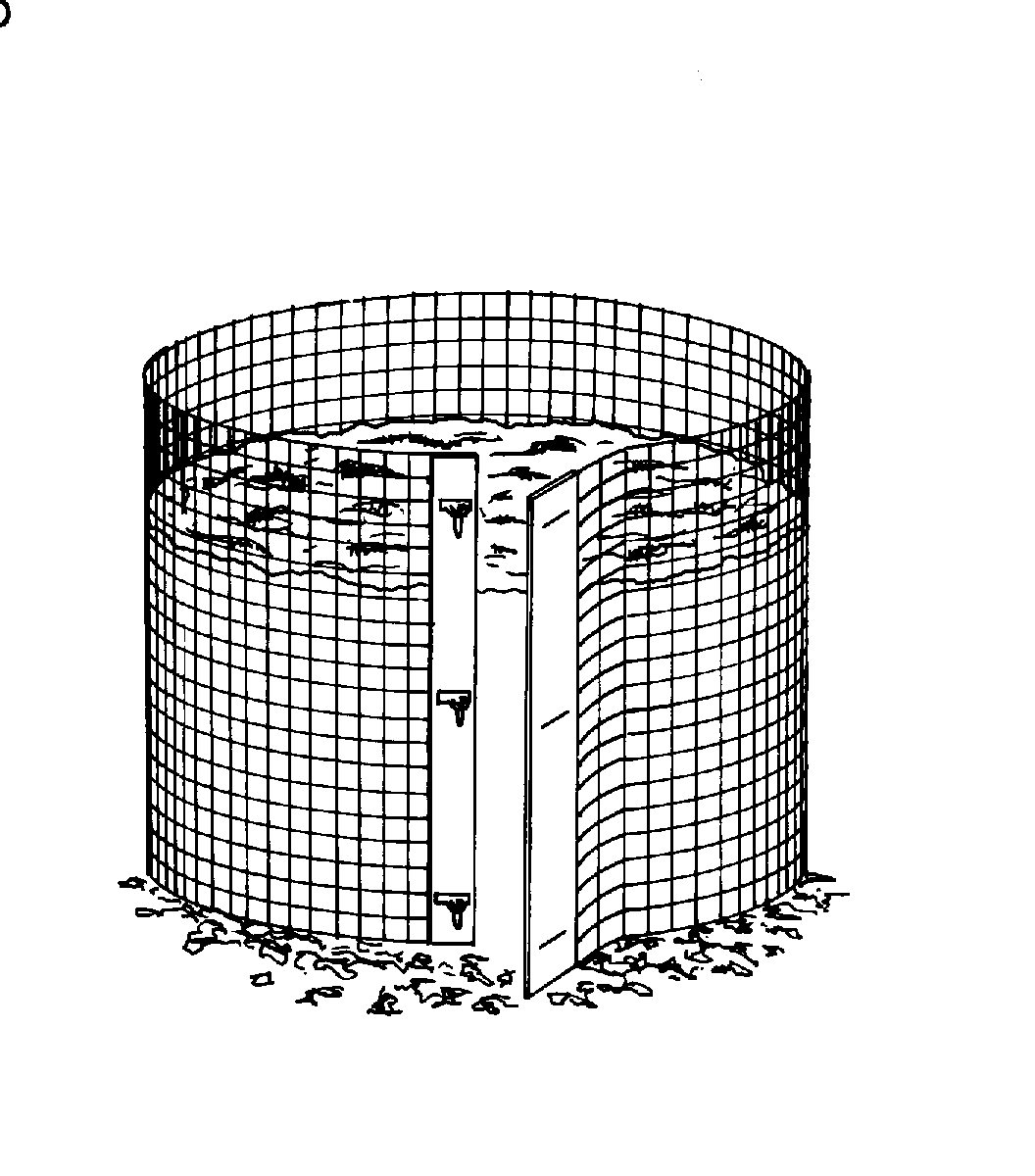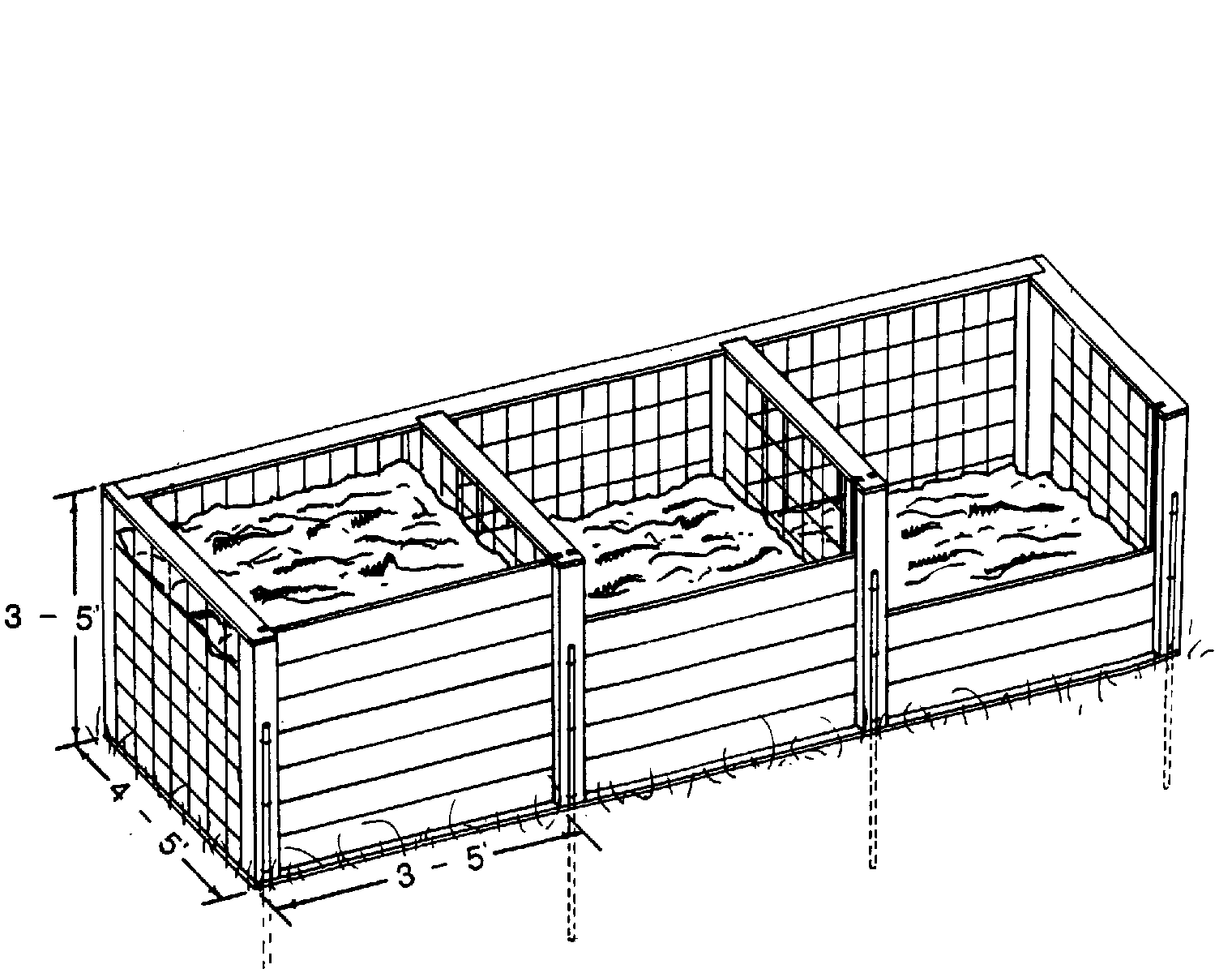



Gardeners have used compost for centuries. When materials such as leaves and grass clippings are composted, a microbial processconverts plant wastes to a more usable organic amendment. Grass clippings and leaves can be hauled to municipal or county composting facilities as one means of disposal. However, many homeowners mayfind it more convenient and economical to compost these materials intheir own backyards. In either case, the finished compost can be usedas a soil amendment or mulch to improve most soils for gardens,landscape beds, lawn preparation or even as 15 % of a potting medium.This leaf let has been written to provide guidelines on how to build and maintain a compost pile.
Decomposition of organic material in the compost pile is dependenton maintaining microbial activity. Any factor which slows or haltsmicrobial growth will also impede the composting process. Efficientde composition will occur if the following factors are used to fullest advantage.
Aeration: Oxygen is required for microbes to efficiently decompose the organic wastes. Some decomposition will occur in the absence ofoxygen (anaerobic conditions); however, the process is slow and foulodors may develop. Because of the odor problem, composting without oxygen is not recommended in a residential setting unless the processis conducted in a fully closed system. Turning the pile once or twicea month will provide the necessary oxygen and significantly hasten the composting process. A pile that is not mixed may take three tofour times longer before it can be used. A well mixed compost pilewill also reach higher temperatures which will help destroy weed seeds and pathogens.
Moisture: Adequate moisture is essential for microbial activity. Adry compost pile will not decompose efficiently. If rainfall islimited, it will be necessary to water the pile periodically tomaintain a steady decomposition rate. Enough water should be added to completely moisten the pile, but overwatering should be avoided.Excess water can lead to anaerobic conditions. Water the pile so thatit is damp, but does not remain soggy. The compost will be within theright moisture range if a few drops of water can be squeezed from a handful of material. If no water can be squeezed out, the material istoo dry. If water gushes from your hand, it is too wet.
Particle size: The smaller the size of organic wastes, the fasterthe compost will be ready for use. Smaller particles have much moresurface area that can be attacked by microbes. A shredder can be usedbefore putting material in the pile, and is essential if brush orsticks are to be composted. A low cost method of reducing the size offallen tree leaves is to mow the lawn before raking or run the lawnmower over leaf piles after raking. Raked piles should be checked toinsure that they do not contain sticks or rocks which could cause injury during operation of the mower. If the mower has an appropriate bag attachment, the shredded leaves can be collected directly. Inaddition to speeding up the composting process, shredding will initially reduce the volume of the compost pile.
Fertilizer and Lime: Microbial activity is affected by the carbonto nitrogen ratio of the organic waste. Because microbes require acertain amount of nitrogen for their own metabolism and growth, a shortage of nitrogen will slow down the composting process considerably. Materials high in carbon relative to nitrogen such asstraw or sawdust will decompose very slowly unless nitrogen fertilizer is added. Tree leaves are higher in nitrogen than straw or sawdust but decomposition of leaves would still benefit from anaddition of nitrogen fertilizer or components high in nitrogen. Grass clippings are generally high in nitrogen and when mixed properly with leaves will enhance decomposition. Poultry litter, manure or bloodmeal can be used as organic sources of nitrogen. Otherwise, a fertilizer with a high nitrogen analysis (10-30 %) should be used.Other nutrients such as phosphorus and potassium are usually presentin adequate amounts for decomposition.
During the initial states of decomposition organic acids are produced, decreasing the pH. In the past, small amounts of lime havebeen suggested for maintaining and enhancing microbial activity atthis time. However, high rates of lime will convert ammonium nitrogento ammonia gas which will lead to the loss of nitrogen from the pile.Research indicated that lime additions may hasten decomposition; however, the loss of nitrogen from the pile often offsets thebenefits of lime. In general, lime is not necessary for degradation of most yard wastes. The pH of finished compost is usually alkaline(pH= 7.1-7.5) without the addition of lime. If large quantities ofpine needles, pine bark, or vegetable and fruit wastes are composted,additional lime may be necessary.
Many organic materials are suitable for composting. Yard wastes,such as leaves, grass clippings, straw, and non woody plant trimmings can be composted. Leaves are the dominant organic waste in mostbackyard compost piles. Grass clippings can be composted; however,with proper lawn management, clippings do not need to be removed from the lawn (see North Carolina Extension Bulletin Carolina Lawns,AG-69). If clippings are used, it is advisable to mix them with other yard wastes, otherwise the grass clippings may compact and restrict airflow. Branches and twigs greater than1/4 inch in diameter should be putthrough a shredder/chipper. Kitchen wastes such as vegetable scraps,coffee grounds, and eggshells may also be added.
Sawdust may be added in moderate amounts if additional nitrogen isapplied. Approximately 1 lb. of actual nitrogen (6 cups of ammoniumnitrate) is required for 100 lbs. of dry sawdust. Wood ashes act as alime source and if used should only be added in small amounts (nomore than 1 cup per bushel or 10 pounds per ton of compost). Ordinary black and white newspaper can be composted; however, the nitrogencontent is low and will consequently slow down the rate of decomposition. If paper is composted, it should not be more than 10 %of the total weight of the material in the compost pile.
Examples of other organic materials that can be used to add nutrients to the pile include: blood meal, bone meal, livestock manure, non-woody clippings, vegetable and flower garden refuse, hay,straw and lake plants. Livestock manure and poultry litter arenitrogen sources for composting. Approximately 100 pounds of poultrylitter will provide 1.8 pounds of nitrogen.
Some materials may pose a health hazard or create a nuisance andtherefore should not be used to make compost. Adding human or petfeces cannot be recommended because they may transmit diseases. Meat, bones, grease, whole eggs, and dairy products should not be added because they can attract rodents to the site. Most plant disease organisms and weed seeds are destroyed during the composting process when temperatures in the center of the pile reach 150-1600F.
Although plants that have been treated with herbicides or pesticides should be avoided for composting, small amounts of herbicide-treated plants (e.g., grass clippings) may be mixed in the pile as long as one is careful to allow thorough decomposition. Ideally, clippings from lawns recently treated with herbicides should be left on the lawn to decompose.
Use of plastic garbage bags is perhaps the simplest way to make compost. The bags are easy to handle, and require minimal maintenance. To make compost using this method, 30-40 gallon plastic bags should be alternatively filled with plant wastes, fertilizer andlime. About one tablespoon of a garden fertilizer with a highnitrogen content should be used per bag. Lime (one cup per bag) helps counteract the extra acidity caused by anaerobic composting. Afterfilling, add about a quart of water. Close tightly. Set aside for sixmonths to a year. Bags can be set in a basement or heated garage forbetter decomposition during winter months. Using garbage bags requires no turning or additional water after closing. The main advantage of composting in garbage bags is that it requires little maintenance; however, because oxygen is limited, the process isslow.
The barrel or drum composter generates compost is a relatively short period of time and provides an easy mechanism for turning(Figure 1). This method requires a barrel of at least 55 gallons witha secure lid. Be sure that the barrel was not used to store toxic chemicals. Drill 6-9 rows of 1/2inch holes over the length of the barrel to allow for air circulation and drainage of excess moisture. Place the barrel upright on blocks to allow bottom air circulation. Fill the barrel3/4 full with organic waste material and add about 1/4 cup ofhigh (approximately 30 %N) nitrogen containing fertilizer. Apply water until compost is moist but not soggy.
 Figure 1. |
Every few days, turn the drum on its side and roll it around the yard to mix and aerate the compost. The lid can be removed after turning to allow for air penetration. Ideally, the compost should beready in two to four months. The barrel composter is an excellent choice for the city dweller with a relatively small yard.
For larger quantities of organic waste, bin type structures arethe most practical. As an example, a circular bin can be made byusing a length of small spaced woven wire fencing and holding it together with chain snaps (Figure 2). The bin should be about three to five feet in diameter and at least four feet high. A stake may bedriven in the middle of the bin before adding material to help maintain the shape of the pile and to facilitate adding water. With this design, it is easiest to turn the composting material by simplyunsnapping the wire, moving the wire cylinder a few feet, and turning the compost back into it.
 Figure 2. |
A very efficient and durable structure for fast composting is athree-chambered bin (Figure 3). It holds a considerable amount of compost, and allows good air circulation. The three chambered binworks on an assembly line idea, having three batches of compost invarying stages of decomposition. The compost material is started inthe first bin and allowed to heat up for three to five days. Next, itis turned into the middle bin for another 4-7 days, while a new batch of material is started in the first bin. Finally, the material in the middle bin is turned into the last bin as finished or nearly finishedcompost.
 Figure 3. |
To make a three-chambered bin, it is best to use rot resistant wood such as redwood, salt treated wood or wood treated with an environmentally safe preservative or a combination of treated woodand metal posts. Unless the wood is treated or rot resistant, it will decompose within a few years. Each bin should be at least three tofive feet in each dimension to contain enough volume to compost properly. Using removable slats in the front offers complete accessto the contents for turning.
The compost pile should be located close to where it will be used and where it will not interfere with activities in the yard or offend neighbors. From the aesthetic point of view, it is best to compost ina location screened from view of both your property and neighbor sproperty. Examples of good locations for the pile include: near the garden or between the garage and house. Do not locate the compostpile near a well or on a slope that drains to surface water such as astream or a pond. The pile will do best where it is protected from drying winds and in partial sunlight to help heat the pile. The more wind and sun the pile is exposed to, the more water it will need.Locating the pile too close to trees may also create problems asroots may grow into the bottom of the pile and make turning and handling the compost difficult.
Organic wastes, such as leaves, grass, and plant trimmings are putdown in a layer eight to ten inches deep. Coarser materials will decompose faster if placed in the bottom layer. This layer should be watered until moist, but not soggy. A nitrogen source should be placed on top of this layer. Use one to two inches of live stock manure, or a nitrogen fertilizer such as ammonium nitrate or ammoniumsul fate at a rate of one third of a cup for every twenty five square feet of surface area. If these nitrogen sources are not available,one cup of 10-10-10 fertilizer per 25 square feet of surface areawill also suffice. Do not use fertilizer that contains herbicide orpesticide.
About a one inch layer of soil or completed compost can be applied on top of the fertilizer layer. One purpose of adding soil is to ensure that the pile is inoculated with decomposing microbes. The useof soil in a compost pile should be considered optional. In mostcases, organic yards wastes such as grass clippings or leaves containenough microorganisms on the surface to effect decomposition. Studies have shown that there is no advantage in purchasing a compost starteror inoculum. One way to insure that activator microbes are present inthe new compost is to mix in some old compost as the pile is prepared.
Most compost piles should initially be prepared in layers. Thiswill facilitate decomposition by insuring proper mixing. Each pile ideally should be about 5 feet high. If only tree leaves are to be composted, layering may not be necessary. Fallen leaves can be addedas they are collected. Leaves should be moistened if they are dry and since dead leaves lack adequate nitrogen for rapid decomposition,addition of a high-nitrogen fertilizer (10-30 % analysis) should beadded to speed up breakdown. Approximately 5 ounces (about1/2 cup) of 10% nitrogen fertilizershould be added for each 20 gallons of hand compressed leaves.
To prevent odors and hasten decomposition, the pile must be turnedoccasionally. Turning also exposes seeds, insect larvae, and pathogens to lethal temperatures inside the pile. Odors may arise either from the addition of excessive amounts of wet plant materials like fruits or grass clippings, or from overwatering. A properly mixed and adequately turned compost heap will not have objectionable odors. An actively decomposing pile will reach temperatures of130-160 0F in the middle.
Reasons for the pile not heating up may be due to: too small apile, not enough nitrogen, lack of oxygen, too much or not enoughmoisture. The pile should be turned when the temperature in the center begins to cool. This will introduce oxygen and undecomposedmaterial into the center and subsequently regenerate heating. Thecomposting process is essentially complete when mixing no longer produces heat in the pile.
Generally, a well managed compost pile with shredded material under warm conditions will be ready in about 2-4 months. A pile left unattended and material not shredded may take over a year todecompose. Piles prepared in the late fall will not be ready for usethe following spring. When the compost is finished, the pile will beabout half its original size and have an earthy smell to it.
|
Click below to e-mail this article to a friend |
|---|
Written by: Larry Bass,Extension Horticultural Specialist, Department of Horticultural Science, North Carolina State University, North Carolina Cooperative Extension Service
RELATED LINKS:

| * * * IN-HOUSE RESOURCES * * * |
|---|